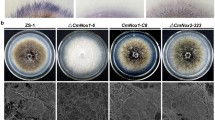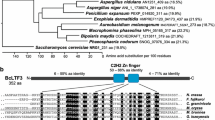Abstract
Rubber anthracnose caused by Colletotrichum gloeosporioides leads to huge economic loss in the natural rubber industry every year. Conidia of C. gloeosporioides are a major infection source but little is known about molecular mechanisms underlying conidial development and infection. In this study, the C. gloeosporioide C2H2 zinc-finger protein transcription factor gene CgAzf1 is shown to be involved in melanin production, conidial development and infection. Deletion of CgAzf1 resulted in decreased melanin production and hydrophilicity of aerial mycelium was increased. The mutants also showed reduced conidiation, low germination rate, and the formation of appressorium lagged too. Virulence assays showed that the CgAzf1 deletion strain could not infect intact rubber tree leaves and had an attenuated virulence on the wounded leaves. Quantitative RT-PCR showed that CgAzf1 regulates expression of genes involved in the MAPK, cAMP-PKA and melanin biosynthesis pathways.







Similar content being viewed by others
References
Adachi K, Hamer JE (1998) Divergent cAMP signaling pathways regulate growth and pathogenensis in the rice blast fungus Magnaporthe grisea. Plant Cell 10:1361–1373
Bhadauria V, Wang LX, Peng YL (2010) Proteomic changes associated with deletion of the Magnaporthe oryzae conidial morphology-regulating gene COM1. Biol Direct 5:61
Gomes S, Prieto P, Martins-Lopes P, Carvalho T, Martin A, Guedes-Pinto H (2009) Development of Colletotrichum acutatum on tolerant and susceptible Olea europaea L. cultivars: a microscopic analysis. Mycopathologia 168:203–211
Jean G, Edith NO, Fabrice P (2005) Some epidemiological investigations on Colletotrichum leaf disease on rubber tree. Crop Prot 24:65–77
Li X, Han X, Liu Z, He C (2013) The function and properties of the transcriptional regulator COS1 in Magnaporthe oryzae. Fungal Biol 117:239–249
Li X, Wu Y, Liu Z, Zhang C (2017) The function and transcriptome analysis of a bZIP transcription factor CgAP1 in Colletotrichum gloeosporioides. Microbiol Res 197:39–48
Liu Z, Wu M, Ke Z, Liu W, Li X (2018) Functional analysis of a regulator of G-protein signaling CgRGS1 in the rubber tree anthracnose fungus Colletotrichum gloeosporioides. Arch Microbiol 200:391–400
Livak KJ, Schmittgen TD (2001) Analysis of relative gene expression data using real-time quantitative PCR and the 2−∆∆CT method. Methods 25:402–408
Pareek M, Rajam MV (2017) RNAi-mediated silencing of MAP kinase signalling genes (Fmk1, Hog1, and Pbs2) in Fusarium oxysporum reduces pathogenesis on tomato plants. Fungal Biol 121:775–784
Priyatno TP, Abu Bakar FD, Kamaruddin N, Mahadi NM, Abdul Murad AM (2012) Inactivation of the catalytic subunit of cAMP-dependent protein kinase A causes delayed appressorium formation and reduced pathogenicity of Colletotrichum gloeosporioides. Sci World J 2012:545784
Prusky D, Lichter A (2008) Mechanisms modulating fungal attack in post-harvest pathogen interactions and their control. Eur J Plant Pathol 121:281–289
Shelp BJ, Bown AW, McLean MD (1999) Metabolism and functions of gamma-aminobutyric acid. Trends Plant Sci 4:446–452
Slattery MG, Liko D, Heideman W (2006) The function and properties of the Azf1 transcriptional regulator change with growth conditions in Saccharomyces cerevisiae. Eukaryot Cell 5:313–320
Talbot NJ, Ebbole DJ, Hamer JE (1993) Identification and characterization of MPGI, a gene involved in pathogenicity from the rice blast fungus Magnaporthe grisea. Plant Cell 5:1575–1590
Tamura K, Stecher G, Peterson D, Filipski A, Kumar S (2013) MEGA6: molecular evolutionary genetics analysis version 6.0. Mol Biol Evol 30:2725–2729
Tsuji G, Kenmochi Y, Takano Y, Sweigard J, Farrall L, Furusawa I, Horino O, Kubo Y (2000) Novel fungal transcriptional activators, Cmr1p of Colletotrichum lagenarium and Pig1p of Magnaporthe grisea, contain Cys2His2 zinc finger and Zn(II)2Cys6 binuclear cluster DNA-binding motifs and regulate transcription of melanin biosynthesis genes in a developmentally specific manner. Mol Microbiol 38:940–954
Wang X, Xu X, Liang Y, Wang Y, Tian C (2018) A Cdc42 homolog in Colletotrichum gloeosporioides regulates morphological development and is required for ROS-mediated plant infection. Curr Genet 64:1153–1169
Wösten HA (2001) Hydrophobins: multipurpose proteins. Annu Rev Microbiol 55:625–646
Wösten HA, Schuren FH, Wessels JG (1994) Interfacial self-assembly of a hydrophobin into an amphipathic protein membrane mediates fungal attachment to hydrophobic surfaces. EMBO J 13:5848–5854
Xu JR, Urban M, Sweigard JA, Hamer JE (1997) The CPKA gene of Magnaporthe grisea is essential for appressorial penetration. Mol Plant Microbe Interact 10:187–194
Zheng W, Zhao Z, Chen J, Liu W, Ke H, Zhou J, Lu G, Darvill AG, Albersheim P, Wu S, Wang Z (2009) A Cdc42 ortholog is required for penetration and virulence of Magnaporthe grisea. Fungal Genet Biol 46:450–460
Zhou ZZ, Li GH, Lin CH, He CZ (2009) Conidiophore Stalk-less1 encodes a putative zinc-finger protein involved in the early stage of conidiation and mycelial infection in Magnaporthe oryzae. Mol Plant Microbe Interact 22:402–410
Acknowledgements
This research was supported by the National Natural Science Foundation of China (Grant Nos. 31860480 and 31560045).
Author information
Authors and Affiliations
Corresponding author
Ethics declarations
Conflict of interest
The authors declare that they have no conflict of interest.
Additional information
Publisher's Note
Springer Nature remains neutral with regard to jurisdictional claims in published maps and institutional affiliations.
Rights and permissions
About this article
Cite this article
Li, X., Ke, Z., Yu, X. et al. Transcription factor CgAzf1 regulates melanin production, conidial development and infection in Colletotrichum gloeosporioides. Antonie van Leeuwenhoek 112, 1095–1104 (2019). https://doi.org/10.1007/s10482-019-01243-1
Received:
Accepted:
Published:
Issue Date:
DOI: https://doi.org/10.1007/s10482-019-01243-1




